
An internet resource developed by
Christopher D. Green
York University, Toronto, Ontario
(Return to index)
By Mary Whiton Calkins (1896)
First published in Psychological Review Monograph Supplement, 1, No. 2.
PART II.
EXPERIMENTAL INVESTIGATION OF CONDITIONS OF ASSOCIATIVE SUGGESTIBILITY.
Experimental investigation may best supplement the purely introspective study of the nature of association by describing in relatively concrete terms the probable direction of trains of associated images. To this end there is necessary such a consideration of the so-called suggestibility of objects of consciousness as shall answer the question: what one of the numberless images which might conceivably follow upon the present percept or image will actually be associated with it?
Ordinary self-observation has long recognized that the readily associated objects are the 'interesting' ones, and has further enumerated frequency, recency, vividness or impressiveness, and primacy (the earliest position in a definite series of events) as the factors of interest, and therefore the conditions of association. A given object, then, is likely to be suggested by one with which it was frequently, recently or vividly connected, and by one with which it stood at the beginning of a series.
Logically prior to the discussion of suggestibility is the study of the suggestiveness of objects of consciousness, that is, the consideration of the question: what part of the present total content of consciousness will be associated with a following image? The suggesting object may, of course, be of varied extent. In the rare cases of 'total redintegration,' practically the entire present content is connected, as a whole, with what follows. Far more often, some one accentuated part of the total object of consciousness is the starting point of the association; and this emphasis of attention is once more upon the 'interesting' part of the entire content, that is upon some vivid, recent or repeated object, or upon one which has had the early place in a series. Finally, neither the total content of consciousness, nor a single accentuated portion of that total, but a [p. 36] group of these single factors or objects of consciousness may form the starting point of the association.
These distinctions may be summarized, somewhat as follows :
I. Contents of consciousness are 'suggestive.'
a. As totals (Total Redintegration.)
b. As complex.
I. Groups of objects are suggestive (through 'constellation.')
2. Single portions are suggestive, through their interest, due to
(a) Repetition (Frequency.)
(b) Vividness.
(c) Recency.
(d) Primacy.
II. Objects of consciousness are 'suggestible,' through their interest, due to
a. Frequency of connection.
b. Vividness " "
c. Recency " "
d. Primacy " "
The experimental investigation whose results are here re ported concerned itself with the conditions of suggestibility.
The relative significance of frequency, recency, primacy and vividness, was studied in about 2,200 experiments. This number does not include the introductory experiments undertaken in order to select satisfactory methods nor the practice experiments of each subject. There were 17 subjects, no one of whom assisted in more than 275 nor in less than 40 experiments; and the average number was 130 for each subject. Most of the visual experiments were repeated with 40 members of the writer's Wellesley College class, with an average of 12 experiments each. The results coincide very closely with those of the more extended study in the Harvard laboratory; they are not included except in one or two instances which will be noticed. All the subjects were entirely or comparatively ignorant of the aims and the problems of the investigation, which was not discussed until the conclusion of the work. The results [p. 37] were twice set down, once in the books kept for the individual subjects, and again in the books which contained the grouped records of the different sorts of experiment. These experimental ledger pages have been balanced, and all the figures given in the tables represent the concurring results of both forms of record. Constant notes were kept of subjective experiences, but have not been reported, for none of them tended to modify the conclusions drawn from the experiments themselves except where the occurrence of natural associations made it necessary to reject entirely the results of particular experiments.
The experiments were of two main types, visual and auditory; the visual experiments are divided again into the successive and the simultaneous; finally, all the experiments may be classed, with reference to their purpose, as simple or comparative.
I. SIMPLE SERIES.
a. I. Successive Arrangement. Visual Series.
The method of the visual experiments was as follows: the subjects, of whom two to eight were present at one time, sat before a white screen large enough to shield the conductor of the experiment. Through an opening, 10 cm. square, a color was shown for four seconds, followed immediately by a numeral, usually black on a white ground, for the same time. After a pause of about eight seconds, during which the subject looked steadily at the white background, another color was shown, succeeded at once by a second numeral, each exposed for four seconds. The pause of eight seconds followed, and the series of 7, 10 or 12 pairs of quickly succeeding color and numeral was continued in the same way. At the close a series was shown of the same colors in altered order, and the subject was asked, as each color appeared, to write down the suggested numerals if any such occurred. The pause between the combination-series, in which colors and numerals appeared together, and the test-series, in which the colors only were shown, was eight seconds in the case of the short series and four to six seconds in the case of the longer. Color and numeral were placed together in their position behind the opening [p. 38]of the screen, the numeral at first concealed by the color, which was then slipped out. There was thus a merely momentary pause between the appearance of color and of numeral. During the eight-second pauses the opening was filled by a white ground, 1/2 cm. behind the screen. The subject thus saw nothing in the opening except this white ground, or the color, which filled the whole square, or the printed numeral; the movements of the experimenter were entirely concealed. The time was at first kept by following the ticks of a watch suspended close to the experimenter's ear; but in the last 1,200 tests by listening to the beats of a metronome, which rung a bell every four seconds; the metronome was enclosed in a sound-proof box, so that the subjects were not disturbed by the beats, which reached the experimenter through a rubber tube. All the series were carefully placed in order beforehand.
In the first group of experiments, some one color appeared several times in each series, once in an unimportant position with any chance numeral, but also once or more in some emphasized connection-either repeatedly with the same numeral (a 'frequent' combination), or at the very beginning or very end of a series (cases of 'primacy' and of 'recency'), or with a numeral of unusual size or color (an instance of 'vividness').
The following are representative series:
Visual series 89. Frequency (3: 12).
I. (Combination Series.) Green, 47; brown, 73; violet, 61 (f); light grey, 58; violet, 61 (f); orange, 84; blue, 12; violet, 61 (f); medium grey, 39; violet, 26 (n); light green, 78; strawberry, 52.
II. (Test Series.) Blue, light grey, strawberry, green, violet (f), orange, brown, medium grey, light green.
Visual Series, 213. Vividness.
I. Brown, 34; peacock, 65; orange, 51; green, 792 (v); blue, 19; violet, 48; green, 27 (n); grey, 36; strawberry, 87 ; dark red, 54.
II. Blue, grey, dark red, brown, green (v), orange, strawberry, grey, peacock. [p. 39]
Visual Series, 127. Recency.
I. Peacock, 46; blue, 38 (n); brown, 51; grey, 74; yellow, 29; blue, 52 (r).
II. Grey, blue (r), peacock, yellow, strawberry, brown.
Visual Series, 69b. Primacy.
I. Light red, 48 (p); strawberry, 13; violet, 60; grey, 82; orange, 29; light red, 31 (n); yellow, 53; green, 94; light violet, 17; blue, 69.
II. Green, gray, light red (p), light violet, strawberry, orange, violet, yellow, blue.
The problem of the experiment is the discovery of the pro portion of cases in which the accentuated color, e.g., green (as in series 213, above), suggests the numeral -- here 792 -- with which it was emphatically combined, instead of suggesting the other numeral with which also it was shown.
To gain a basis of comparison about 1,300 series of all types, and from the records of all the subjects, have been considered as a mere memory test, leaving out of account, for the time being, the emphasized combinations which they contain. About one-fourth of the ordinary combinations in the longer series (10 to 12 pairs), and one-third in the shorter series (7 pairs) are remembered. This is shown in

In this calculation, and in all similar ones, all cases were excluded in which any accidental association already existed between color (or syllable) and numeral. If the color was thus naturally associated with the emphasized or the contrasted numeral, the whole series was excluded; otherwise, as in the cases included under this table, merely the combination thus connected was set aside.
The tabulated results of the experiments on frequency as a condition of association are as follows: [p. 40]

The table shows the number of those cases in which both numerals were recalled, then the number of cases in which the color suggested only the numeral with which it had been but once associated, and in the last group the number of times in which that numeral was recalled with which the color had been twice or three times combined. Under the heading 'Half' are given those cases in which one digit of the numeral was recalled, and in estimating per cents. these cases are rated as half correct. The comparison of the 'frequent' with the unemphasized, that is the 'normal,' shows that, with repetitions amounting to one in four, the repeated numeral is associated in 63·7% of the possible cases (44.5+19.2%), the normal in only 24.9% (5.7+19.2%). When only one numeral is suggested, the 'frequent' appears more than seven times as often as the once combined numeral.
The comparison of both these per cents. with that representing the likelihood of recall for such long series (Table I.) leads to the same conclusion. The frequency combined numeral is associated more than twice as often (63.7% instead of 26.1%), while the unemphasized numeral is associated slightly less often, than the average (24.9% instead of 26.1%). This latter comparison, which, however, needs substantiation by a greater number of experiments, suggests the negative result of habit, since the effect of habitual combination with a given stimulus is seen to be a small decrease of the likelihood of ordinary connection with the same stimulus. In the case of subjects with retentive memories-observe, for instance, the record which follows, of Sh. -- 'both' numerals are likely to be recalled, the normal as well as the frequent. This is easily explained when the normal comes late in the series for the occurrence of a color already accentuated by repetition may direct the attention to the following numeral even when that is not emphasized. This [p. 41] fact makes the general lowering of the percentage of recall of the normal in the 'frequent' series the more striking.
It must be added that in the case of the frequent and the vivid series this influence of position was eliminated by constantly changing the place of the unemphasized pair of stimuli; thus, in the 'vivid' series the normal and the vivid combination alternated between the early middle and the late middle parts of the series; and in the 'frequent' series the normal was placed successively in the early, the early middle, the late middle or the late part of the series. From the results it appears that the normal combination is slightly more likely to be forgotten if placed in the early part of the series, but this does not alter the general tendency.
It is noticeable, also, that the influence of repetition is much lowered when the 'frequent' combination appears twice only instead of three times. The second line of Table II. gives the results; the 'frequent' numeral is recalled in 34.9% of the series (21.3+13.6%) which is only 8.8% more than the ordinary average of associations without repetition, and 28.8% less than the proportion of three times repeated associations. The table of individual records is therefore given only for the one-fourth frequency series; it shows that the results are not due to any misleading massing of the figures, for the preponderance of 'frequency' associations appears for each subject. [p. 42]

The greatest difficulty of these experiments was unquestionably in the study of vividness as a condition of suggestibility. The category is a vague and elusive one, seeming to include all those forms of the interesting which cannot be referred to the repetition, the recency or the primacy of the experience. In the main, therefore, the 'vivid' is either the 'unusual,' or it is the object of instinctive, and therefore of psychologically inexplicable, interest.
The following summary distinguishes the different devices used to make the combinations 'vivid.' Since the color was always repeated, this result could only be secured by varying the numeral, which was accordingly either black, of two digits, but much smaller than the other numerals (B2S) ; or black, of usual size, but of three digits (B3) ; or of usual size and of two digits, but red (R2); or, finally, of usual size but of three digits and red (R3), About 200 records obtained from experiments at Wellesley are added to the table. [p. 43]

The comparison of these different sorts of impressiveness shows an interesting preponderance of associating three place black numerals (52.4%) over associating black numerals of only two digits (29.9%). Since the latter were visually very striking, because so small, this difference is very likely due to the fact that the numerals of three places, introducing, if pronounced, the word 'hundred,' are helped by the articulatory memory. Only the Harvard records are used in the following table of individual results.

Thus the vividly-associated numerals are remembered in about one-half (52.2%) of the series, while the normal associations with the same colors are only one-fifth (20.8%) of the entire number. The lessened strength of these sorts of vividness, as compared with that of the three repetitions, is shown by the [p. 44] greater number of cases in which neither numeral is remembered. J.P., however, is the only one of the subjects whose records, only 10 in number, show no influence at all of vividness.
In the attempt to fix a rate of associative recency, series were used varying in length from 4 to 7 pairs. Only the series of 7 pairs proved suitable to the purpose, for in the shorter ones both numerals were usually recalled so that a comparison became impossible. The 'recent' color, which appeared last, of course, in the combination series was placed second, not first, in the test-series, in order that no after-image of the numeral might remain. The individual records which are grouped in the following table offer only one variation from the type, again in the case of J.P. They show that the last numeral is recalled in 53.7% of the possible cases; the other numeral associated with the same color, only in 25.7%.

The influence of recency has been studied also in the series which were arranged without this immediate end in view, by recording all cases in which the last numeral was correctly associated with the color on which it had followed. In these cases the likelihood of recall does not surpass that of the average numeral, [p. 45] though the 'recent' color was shown third in the second half-series: the recall of the recent numeral occurred only in 26.4% of 276 series. The swiftly decreasing influence of recency, well-known from such experiments as those of Ebbinghaus on memory, is thus clearly indicated: even the intervention of only two colors between the last combination of color and numeral and the reappearance of the color was sufficient to annihilate the effect of the recency.
Finally, the suggestibility of a numeral which had already appeared at the very beginning of a series was compared with that of another numeral combined with the same color midway in the series.

The table shows very clearly that with long series, primacy is a significant factor only in individual cases. Thus, its influence is very marked on R.'s associations, and may be observed in the records of Mc. and Sh. Lh. on the other hand associates the later numeral, that is the 'normal,' much more often, and with four of the other subjects the normal has a slight advantage. A record of cases was also kept in which the first of the series was remembered, without special competition with any other numeral, but the proportion was barely the average one in the long series; in the short series on the other hand the first numeral was associated in more than two-fifths of [p. 46] the cases -- in 43%, that is 8% more often than the average numeral and only 8% less often than the recent.
The ineffectiveness of primacy in the long series seems at first sight to contradict the testimony of common experience and of experiment,[1] for, in committing long series to memory, the learner is certainly very apt to remember the first presentation. This difference, however, is easily explained: in memorizing, the subject sets himself to learn the series as a whole, and he may not only accentuate the first presentation, but recur to it while learning the rest of the series; moreover, when he repeats the series, or records it in writing, he almost invariably gives first the earliest presentation. In the association experiment, on the contrary, the first presentation was always repeated toward the middle of the test-series, thus multiplying the chances that the combination would be crowded out of the memory.
2. Simultaneous Arrangement. Visual Series.
These general results have been amplified, and at the same time verified, by introducing series in which the connected color and numeral were simultaneously shown. This method might have been used more often, since the simultaneous combination of stimuli is perhaps more common in ordinary experience than the successive; but the experiments of the successive type, in which the combination of color and numeral is emphasized by the long pause between each pair, were employed as affording a close comparison between the visual and the auditory series. So far, however, as these subjects are concerned, the results of the simultaneous series are so closely parallel with those of the successive ones that no characteristic differences appear. Color and numeral were shown side by side in an opening 10x4 cm., by slipping them into double passe-partout frames, made for the purpose. Each frame held a color and a numeral separated by a narrow band of white. The intervals of exposure were six seconds, and in a few series four seconds; the pauses were usually six seconds, occasionally four seconds. In each of the three most important simple forms of the experiment, 50 [p. 47] tests were made. The average of recall, leaving out of account the emphasized numerals, was 25.4% for the 100 long series and 30% for the 50 short series, thus falling, as has been said, slightly below the average of recall in the successive series. Moreover the percentage of emphasized numerals which were associated was slightly greater than in the successive series, because of the larger number of cases in which both numerals were recalled. This result, however, may be due to the greater degree of practice when these simultaneous tests were made.
The number of experiments is so small that the individual records are not given, but they are closely parallel with those of the successive series. In the table which follows, the figures for the 'half' correct, which are small, are combined with those of the fully correct, and the corresponding per cents. of the successive series are added in parenthesis.

b. Auditory Series.
All the varieties of experiment which have so far been described, except those in primacy, were repeated with nonsense syllables and numerals, as the association-elements , both pronounced to the subjects. These series were arranged in pairs of a nonsense syllable and a numeral each, with four seconds allowed to the pronunciation of each pair, and four seconds interval both between the pairs and between the two parts of the series. One series will serve as illustration of all.
Series 335b. Vivid, Auditory.
I. Zet, 24; Kip, 62; Tox, 96; Wez, 319 (v); Vit, 38; Lup, 45 ; Nuk, 29; Wez, 73 (n); Vab, 57; Muv, 41.
II. Vit, Kip, Muv, Zet, Wez, Nuk, Lup, Vab, Tox.
The results of the experiments are generally parallel with [p. 48] those of the visual tests, with certain suggestive variations which will be noticed later. The general average of recall, disregarding the accentuated pairs is shown in

The 'frequent' numeral is recalled twice as often as the unemphasized (in 80% as against 40% of the possible cases) as appears from
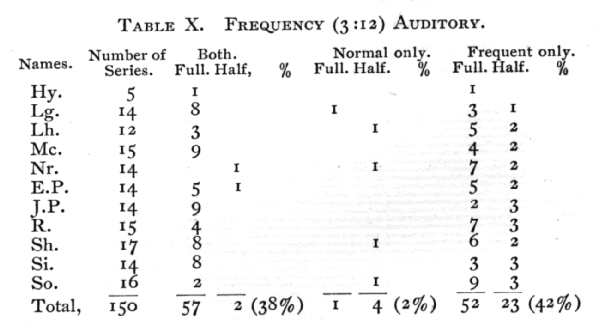
The position of the normal in the series was carefully varied, as In the visual experiments. The following table shows, however, that whatever the position of the normal, associations with the repeated numeral are much in excess, thought they decrease where the normal is midway in the series so that the repetition affects is also.

[p. 49]
Two methods of making a numeral impressive were employed. Sometimes, as in the example given, a numeral of three digits was used. At other times the emphasized numeral was read in a very loud tone. The next summary shows that both methods were effective, but that the voice-stress was a little more impressive.

The individual records show greater variation from the type than the reports of frequency-association .
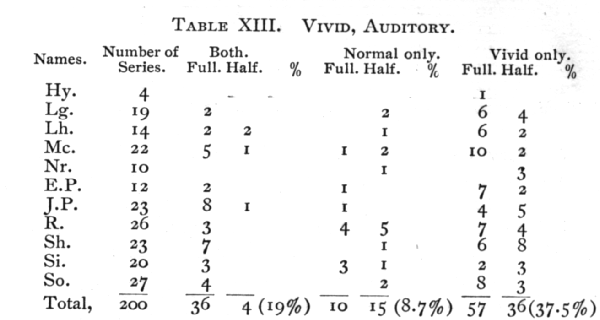
The influence of the position of the normal shows itself, in the other series, in the larger number of cases in which 'both' are remembered, when the normal comes after the vivid combination.

[p. 50]
The records of the recency experiments show the very striking effect of auditory recency. There are no individual variations from the general type, and the number of cases in which the normal is remembered does not rise above one-eighth. In about half the records the 'recent' is wholly or partially remembered in every case.
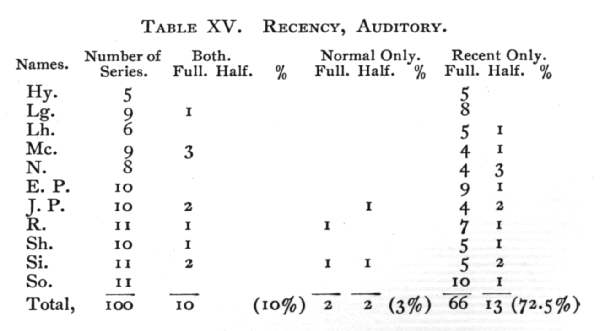
Auditory experiments to determine the effectiveness of primacy were undertaken, but were soon discontinued because they showed from the beginning the insignificance of this factor in long series. In the short auditory series, however, as in the visual, the first position proved very important: the first numeral was associated in 38.4% of the possible cases, that is, in 14% more than the average number.
The general relations of the auditory to the visual series appear in the next table in which only per cents. are given:
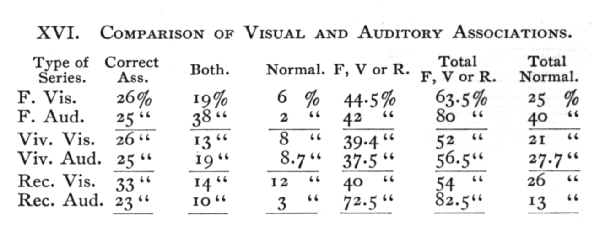
[p. 51]
These figures may seem to contradict Dr. Münsterberg's conclusion[2], from his memory experiments, that "when isolated the visual memory surpasses by far the aural." But the comparison of visual and aural memory in these association-experiments is, in the first place, an unfair one, since the suggesting stimuli differ so much in the two types of experiment, consisting in the one case of colors, in the other of syllables. Furthermore, the figures themselves (in the column of 'Correct Associations') show that the memory for ordinary combinations is rather stronger in the visual series. The suggestiveness, not the reproduction, seems to be increased in the auditory series, and this is very likely a case of the well-known associativeness of language. The preponderance, already noticed, of recency associations is also, perhaps, peculiar to verbal suggestions. At the very least, the auditory experiments corroborate the results of the visual by reproducing these in another sense-material.
II. COMPARATIVE SERIES.
In showing that frequency, vividness, primacy and recentness are conditions of association these experiments have so far, of course, merely substantiated ordinary observation. The real purpose of the investigation is attained only by a comparison of these factors. Already it has appeared that the per cent. of correct 'frequency' associations is slightly the largest, an that recency is the principle of the combination in the next greatest number of cases. In order, however, to carry out the comparison under like conditions, these principles of combination were compared within the same series, To this end, long 'successive' series were arranged in which the significance of frequency was contrasted with that of vividness by showing a color three times with the same two-digit numeral (f) and once with a three-digit numeral (v) ; others, in which the color three times shown with a numeral (f) appeared also at the first of the series with another numeral (p). Short 'successive' series were formed in which the last color (r) had appeared once before [p. 52] with a three-digit numeral (v), or at the very beginning of the series (p), or twice before with a repeated numeral (f).
In the following summary of results of the comparison of frequency and primacy, half the records are those of Wellesley subjects. The individual records are not given because they are few in number and show no variation. The experiments were not continued further because their result was so unmistakable, verifying the conclusion already reached by the study of primacy alone, that this is evidently an unimportant feature of long series.

The comparison of freqruency with vividness shows far less inequality, and yet there is a definite excess of correct associations with frequency. In half the cases where there was any association at all, both the frequent and the vivid numeral were recalled. The records are these:
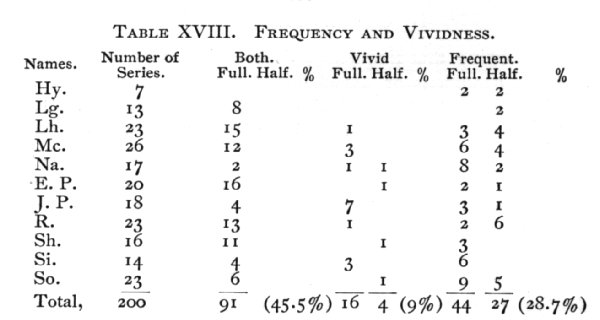
This shows a total of 74.2% (28.7+45.5) of associations with the numeral frequently combined with the color presented, and 54.5% (9+45·5) of associations with the numeral vividly combined. Frequency, however, is not invariably the more determining factor: the records of E.P., Lh., and Sh. Show only a small difference between 'frequent' and 'vivid' associations, while J.P. has more with the vividly combined numeral. [p. 53]
The greater significance of frequency of combination was brought out more strongly by lengthening and filling the interval between the half-series. After the pairs of colors and numerals had been shown to the subjects, short anecdotes or news-items, of about one hundred and fifty words, were rapidly read aloud. The test series, of colors only, was then shown and the subjects tried as usual to associate the numerals. The table shows that the per cent. of association was a little lowered, but that the per cent. of frequency associations is greater than after the unfilled interlude. The frequently combined numerals seem to be more tenaciously associated. This method might with advantage have been extended to the other experiments.

The influence of position in the series does not alter the general relation of frequent and vivid associations, though the greatest number of <frequent associations only' does occur where the vivid numeral is nearest the beginning of the first half-series and so at a relative disadvantage. The greatest likelihood of remembering 'both' occurs when the vivid is near the middle of the series so that it is influenced by the repetition and itself influences the remaining repetitions. All this appears in the following table:
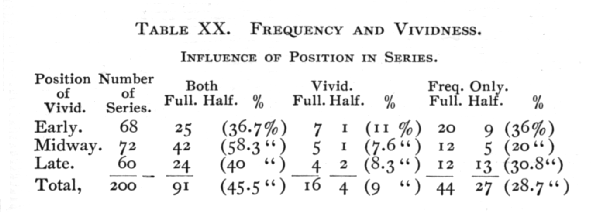
[p. 54]
The results of the comparison of recency with the other conditions of suggestibility is made in the three following tables:
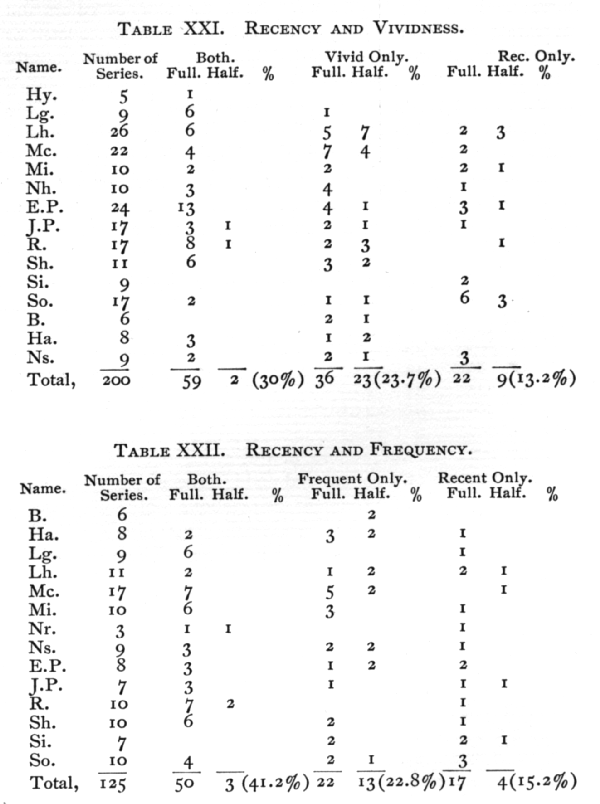
[p. 55]
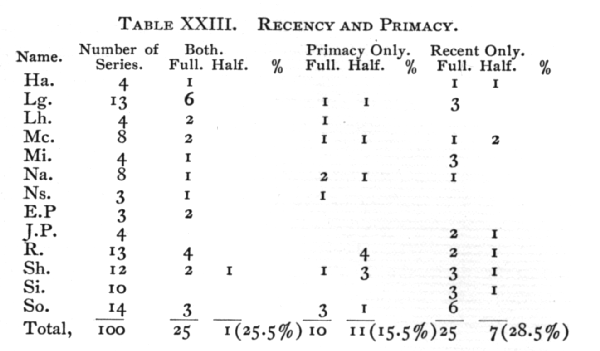
The discussion of these results will be facilitated by comparing the per cents. of the total number of the recent and of the contrasted associations in the different cases:

It appears that in this direct competition recency yields both to frequency and to vividness as a condition of suggestibility. The vivid numeral seems even to suppress the recent, for in the recent-vivid series the recent is recalled 10% less often than in the series where the recent is compared with an ordinary numeral (See Table VI.). On the other hand, the effect of recency is as usual, to raise the likelihood of the recall of the contrasted numeral, but not to the level of the frequent associations.
The associations with the first numeral of the series are decidedly less than those with the recent, though far more numerous than in the longer series. Individual differences, however, are to be noticed here, and would doubtless appear more strongly in a larger number of experiments; they may also be observe in a few records of the other short series, as in that of So., who has few vivid, and many recent, associations.
From this mass of figures a few conclusions emerge into prominence. Some of these have been already formulated, but the more important ones may be briefly stated again. [p. 56]
No one of these generalizations, it should be remarked, is proof against the caprice of the individual, who may have his own favorite type of association which resists opposition. Thus the preference of one of our subjects-So.-for the recent may be traced through almost all the series, often in contradiction of the general result.
Frequency has been the most constant condition of suggestibility. The proportion of the frequent as compared with the normal associations is one-tenth greater than that of the vivid or of the recent. When directly compared with the vivid and the recent the proportion is still greater, though the number of associations with the contrasted numeral is larger than that of the associations with an ordinary one, because of the tendency of the repetition to accentuate the compared factor.
This significance of frequency is rather surprising. For though everybody recognizes the importance of repetition in forming associations, we are yet more accustomed to 'account for' these by referring to recent or to impressive combinations. The possibility that the prominence of frequency in our results is not fairly representative of ordinary trains of association is strengthened by the fact that it is contrasted with forms of vividness which are only two or three of many, and which do not approach the impressiveness, for instance, of richly emotional experiences. But this does not affect the importance of frequency as a corrective influence. Granted a sufficient number of repetitions, it seems possible to supplement, if not actually to supplant, associations which have been formed through impressive or through recent experiences. Moreover, the trustworthiness of the ordinary observation, which relegates frequency to a comparatively unimportant place among the factors of suggestibility, may be seriously questioned: I have found many cases, during experiments in free association in which the subject, asked to explain the association, does not always mention repetition, even when it has obviously occurred, but seems, as it were, to take it for granted. The prominence of frequency is of course of grave importance, for it means the possibility of exercising some control over the life of the imagination and ofdefinitely combating harmful or troublesome associations.
Footnotes
[1] Cf. Dr. W. G. Smith, Psychological Review, III., p. 30.
[2] Psychological Review, I., p. 37.·